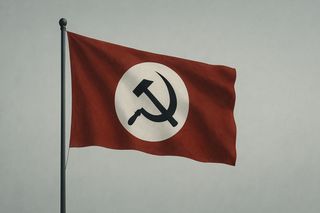If you haven't read Why Facts Don't Change Minds, consider reading it first. This post builds directly on that foundation, and it's my most well-received post by far.
In 2011, Nokia CEO Stephen Elop sent a memo to his employees that would become infamous. "We are standing on a burning platform," he wrote. "We have multiple points of scorching heat that are fueling a blazing fire around us."
Two years later, Nokia sold its mobile phone business to Microsoft for $7.2 billion—a fraction of its peak value of $300 billion. In just five years, the company that had dominated 40% of the global mobile phone market had become irrelevant.
Nokia had everything it needed to succeed in the smartphone era. They had the technology, the manufacturing expertise, the global distribution network, and even early smartphone prototypes. But they struggled to adapt their Symbian platform to the new touchscreen paradigm, while Apple and Google raced ahead with purpose-built smartphone operating systems.
This wasn't a mistake, the system was working exactly as designed.
Setting aside the whole potential Microsoft trojan horse angle for the moment, Nokia's executives weren't stupid or short-sighted. They were intelligent people making rational decisions within an organizational template that had served them brilliantly for decades. The problem wasn't the people—it was the structure of their organizational graph itself.
The Ghost in the Graph #
In 1949, philosopher Gilbert Ryle coined the term "ghost in the machine" to describe what he saw as a fundamental error in how his contemporaries thought about the mind. The phrase captured the mistaken belief that there's some immaterial spirit—a ghost—that inhabits and controls the physical body, like a pilot in a ship.
Ryle's point was that this dualistic thinking creates a false separation. There isn't a ghost separate from the machine; the ghost is just the machine working. The mind isn't something that inhabits the brain—it's what the brain does.
We face a similar error when we think about organizations, institutions or even cultures. We sometimes talk about "company culture" or "organizational DNA" as if these are separate entities that inhabit the structure, when in reality, they are the structure. The ghost isn't something that lives in the organizational graph—it's the graph itself, viewed from a different perspective.
There isn't a ghost separate from the machine; the ghost is just the machine working. The mind isn't something that inhabits the brain—it's what the brain does.
Every institution develops patterns of behavior that emerge from its structure. Not from conscious intention, but from the way information flows, decisions get made, and incentives align. This is why your company's culture feels like it has a personality, why your government seems to have its own agenda, and why your own belief system sometimes resists change even when you want it to.
This is the ghost in the graph—not a separate entity, but a different way of seeing the same organizational structure. When we look at a network of rules, roles, and relationships, we can see it as either a collection of individual parts or as a system with its own patterns. The ghost is just the system working, viewed from the perspective of the system itself rather than its components.
In "Why Facts Don't Change Minds," we discovered that belief systems are living networks that compete, adapt, and sometimes collapse. Now we face the hard question: How do we build better ones? The answer lies in understanding how these emergent patterns work, how they can become trapped in destructive cycles, and how we can design systems that serve human flourishing rather than their own survival.
From Individual Minds to Organizational Patterns #
When individual belief systems interact, they don't just coexist—they combine to create something larger than themselves. The organizational pattern is the sum total of the complex interplay of multiple individual graphs, each influencing and being influenced by the others.
flowchart TB
subgraph MetaBeliefs["Shared Meta-Level Beliefs"]
M1["Code Quality Matters"]
M2["User Experience is Priority"]
M3["Continuous Learning"]
M4["Team Collaboration"]
end
subgraph IndividualBeliefs["Individual Beliefs"]
I1["React is the best framework"]
I2["Security should be built-in"]
I7["Monitoring prevents disasters"]
I8["Features must solve real problems"]
I9["Agile ceremonies are essential"]
I10["Remote work is more productive"]
I11["Code reviews should be async"]
I12["Standup meetings are a waste of time"]
end
subgraph RoleSpecs["Role Specializations"]
A1["Frontend Dev<br/>UI/UX & Performance Focus"]
A2["Backend Dev<br/>API Design & Security"]
A3["DevOps Engineer<br/>Infrastructure & Automation"]
A4["Product Manager<br/>User Research & Prioritization"]
end
subgraph TeamCulture["Emergent Team Culture"]
C1["Code Review Standards<br/>Testing, Documentation, Security"]
C2["Decision-Making Process<br/>Architecture Reviews & RFCs"]
C3["Team Rituals<br/>Standups, Planning, Retrospectives"]
C4["Shared Identity<br/>'We Ship Quality' & 'Users First'"]
end
%% Direct connection from shared beliefs to roles
MetaBeliefs -->|"shapes identity & behavior"| RoleSpecs
%% Key connections between individual beliefs and roles
I1 -->|"expresses through"| A1
I2 -->|"expresses through"| A2
I7 -->|"expresses through"| A3
I8 -->|"expresses through"| A4
I9 -->|"influences team dynamics"| A4
I10 -->|"shapes process preferences"| A1
I11 -->|"affects collaboration style"| A2
I12 -->|"impacts meeting culture"| A3
%% Roles collectively create culture
RoleSpecs -->|"collectively create"| TeamCulture
MetaBeliefs -->|"influence"| IndividualBeliefs
%% Culture feeds back to roles
TeamCulture -.->|"shapes daily behavior"| RoleSpecs
%% Styling
classDef meta stroke:#e3f2fd
classDef individual stroke:#e1f5fe
classDef role stroke:#fff3e0
classDef emergent stroke:#e8f5e8
class M1,M2,M3,M4 meta
class I1,I2,I3,I4,I5,I6,I7,I8,I9,I10,I11,I12 individual
class A1,A2,A3,A4 role
class C1,C2,C3,C4 emergent
This (extremely reductive) diagram shows how a software development team's organizational pattern emerges from the interplay of shared meta-level beliefs and individual specializations. Everyone on the team shares core beliefs about code quality, user experience, continuous learning, and collaboration. But each role—frontend developer, backend developer, DevOps engineer, product manager—brings specialized knowledge and priorities that shape how those shared beliefs are implemented.
The team culture is more than the sum of individual preferences—it's the result of how these specialized perspectives interact and create new patterns. The code review standards, decision-making processes, team rituals, and shared identity that develop become part of the organizational culture that then influences how each team member thinks about their work. A new developer joining the team doesn't just learn individual practices—they absorb the emergent culture that shapes their own belief graph.
From Organizational Patterns to Societal Templates #
Everything you just saw at team scale also happens at national scale. The same principles of emergent organizational patterns—how individual beliefs combine to create collective behavior, how specialized roles shape culture, and how that culture feeds back to influence individual thinking—apply to entire societies. The only difference is the scale and complexity of the networks involved.
When you scale the same principles across an entire society, they can create something even larger: societal templates that define how entire nations think and behave. These templates are the most complex and powerful emergent structures, capable of shaping the beliefs of billions of people across generations.
But how does this scaling actually work? How do millions of individual belief fragments cohere into a massive societal pattern? The answer lies in that each person carries only fragments of the complete template. Some carry deep knowledge of individual shards, some know the broad outlines, but when millions of people interact, their individual shards align to form the larger pattern.
The Russian template provides a clear modern example of this scaling process. At the individual level, Russians carry belief graphs shaped by concepts like "Russian World," "spiritual sovereignty," and "anti-Russia." These individual beliefs don't exist in isolation—they're reinforced by organizational cultures in the security services, state corporations, and the Orthodox Church.
This analysis describes aggregate patterns, not deterministic individual behavior. Not every Russian citizen holds identical beliefs, and individuals can and do resist or reject the template's influence. In addition, the template is increasingly exported abroad. But at the societal level, these organizational cultures create predictable patterns of behavior and belief that persist across generations and regime changes.
graph TD
subgraph IndividualLevel["Individual Belief Graphs"]
I1["'Russian World' Identity"]
I2["'Spiritual Sovereignty' Values"]
I3["'Anti-Russia' Threat Perception"]
I4["'Traditional Values' Morality"]
end
subgraph OrganizationalLevel["Organizational Cultures"]
O1["Siloviki Culture<br/>Security & Loyalty Focus"]
O2["State Corporation Culture<br/>Resource Control & Wealth"]
O3["Orthodox Church Culture<br/>Spiritual Authority & Tradition"]
O4["Presidential Administration<br/>Political Technology & Control"]
end
subgraph SocietalLevel["Societal Template"]
S1["The Russian Template<br/>Hierarchical Social Contract"]
end
%% Individual beliefs influence organizational culture
I1 -->|"shapes identity"| O1
I2 -->|"justifies authority"| O3
I3 -->|"drives security focus"| O1
I4 -->|"reinforces hierarchy"| O2
%% Organizational cultures create societal template
O1 -->|"provides enforcement"| S1
O2 -->|"provides resources"| S1
O3 -->|"provides legitimacy"| S1
O4 -->|"provides coordination"| S1
%% Societal template feeds back to individuals
S1 -.->|"shapes daily reality"| IndividualLevel
%% Styling
classDef individual stroke:#e1f5fe
classDef organizational stroke:#fff3e0
classDef societal stroke:#ffebee
class I1,I2,I3,I4 individual
class O1,O2,O3,O4 organizational
class S1 societal
The Russian template is the interaction of these organizational cultures. The security services provide the enforcement mechanisms, state corporations provide the economic resources, the Orthodox Church provides spiritual legitimacy, and the presidential administration provides political coordination. Together, they create a societal-level template that defines how the entire system works.
This template then feeds back down to shape individual belief graphs. When a Russian citizen encounters information about Ukraine, their interpretation is filtered through the "Russian World" concept that has been reinforced by state media, educational institutions, and social networks. The template doesn't just influence what they believe—it shapes how they process information in the first place.
What makes societal templates so formidable is that they are exceedingly powerful structures that can persist across generations and resist external pressure. The Russian template has survived multiple regime changes, from the Czars to the Soviets to the current system, because the underlying organizational cultures—the security state, the resource extraction system, the spiritual authority—have adapted and evolved while maintaining their core functions. Historians like Stephen Kotkin have documented how these deep institutional patterns persist across seemingly radical political transformations, with the same organizational logics reemerging under different ideological banners.
This is why understanding emergent organizational patterns is so crucial. When we see a nation behaving in ways that seem irrational or self-destructive, we're often witnessing the behavior of a societal template that has become trapped in its own logic. The template isn't making mistakes—it's working exactly as designed. The problem is that the design that worked in one historical context has become maladaptive in another.
The Shards of the Graph: How Individual Minds Carry the Template #
The most remarkable thing about societal templates is that no single person holds the complete picture. Instead, everyone carries fragments—shards of the graph that fit together to create the larger pattern. Some people carry broad outlines of the entire template, while others have deep knowledge of specific parts. A Russian citizen might carry the "Russian World" concept as part of their general worldview, while a siloviki officer has detailed expertise in the "security threat" framework, a church official deeply understands the "spiritual sovereignty" narrative, and a state corporation executive has specialized knowledge of the "resource control" logic. Each person's mental model is incomplete, but when millions of people interact, their individual shards align to form the complete template.
No one person sees the whole picture, but everyone contributes to creating it. The template exists in the collective pattern of how all the shards fit together.
This is why societal templates are so resilient. You can't destroy them by targeting a single person or even a group of people—the template exists in the collective pattern of how all the shards fit together. When one person changes their mind or leaves the system, the template continues because the remaining shards still form a coherent pattern. The pattern persists not because any individual is committed to it, but because the collective arrangement of all the individual fragments creates a stable structure.
This also explains why templates can evolve without anyone consciously planning the change. As individual shards shift—as people's beliefs and behaviors adapt to new circumstances—the overall pattern gradually transforms. The template doesn't change because someone decided to change it; it changes because the collective arrangement of all the individual fragments has shifted into a new stable configuration.
The crucial point is that we're all carrying pieces of the same puzzle, and the picture that emerges from how those pieces fit together is what we call the emergent organizational pattern. No one person sees the whole picture, not in whole detail, but everyone contributes to creating it.
Template Warfare: When Patterns Attack Each Other #
This distributed nature of templates explains something crucial about the Nokia story that we deliberately set aside earlier. When I opened this post, I said we were "setting aside the whole potential Microsoft trojan horse angle for the moment" because I wanted to focus on how organizational templates work from within. But now that we understand how templates function, we can see that Nokia's collapse wasn't just a case of internal template failure—it was arguably also a perfect example of template warfare.
The Nokia case illustrates template warfare, but with an important epistemic caveat: we can observe Elop's actions (the burning platform memo, the Windows Phone pivot, rejecting Android), the timeline (Microsoft → Nokia → back to Microsoft after acquisition), and the financial outcome (Nokia mobile sold for $7.2 billion, which was a fraction of its peak $300 billion valuation, while Elop received a $25.4 million payout, 70% of which came from Microsoft). But we can't know whether Elop genuinely believed Windows Phone was the right strategy, or his actual thought process during key decisions.
A "good faith but incompetent" CEO and a "trojan horse" CEO might make identical decisions if Microsoft's interests happened to align with what the trojan horse was supposed to do. The observable evidence could support either narrative. Even books claiming to debunk the trojan horse theory are necessarily dependent on interviews and public statements—people close to Elop would have every reason to deny conspiracy allegations whether they were true or false.
This epistemic problem itself creates an uneven playing field that makes template warfare more attractive and effective. When the observable evidence can support multiple narratives, the attacker gains a crucial advantage: plausible deniability. Even if Nokia's board had suspected foul play, they couldn't prove it without access to Elop's internal states. This information asymmetry makes template warfare attacks more appealing because they're harder to detect and defend against than overt competition.
What we can analyze with confidence is the template warfare effect: whether Elop was a deliberate trojan horse or simply made decisions that happened to serve Microsoft's interests, the observable outcome was that Microsoft gained tremendously from decisions that appeared rational from within Nokia's template, but were systematically dismantling it from within.
Elop's "burning platform" memo, in effect, was a surgical attack on Nokia's organizational graph. In template warfare terms, the memo simultaneously attacked the core identity node by declaring "We are standing on a burning platform"—a statement that directly contradicted Nokia's "market leader" self-concept. It severed key connections by breaking the link between "Symbian platform" and "competitive advantage," making Nokia's core product feel like a liability rather than an asset. The memo introduced urgency bypass by framing the situation as an emergency, which short-circuited Nokia's normal deliberative processes and prevented careful analysis of alternatives. Finally, it prepared new pathways by priming Nokia employees to accept radical changes, like partnership with Microsoft, as the only path to survival.
This information asymmetry makes template warfare attacks more appealing because they're harder to detect and defend against than overt competition.
The memo was a targeted psychological operation designed to reshape Nokia's belief structure in ways that served Microsoft's template. What makes this especially interesting is that Nokia had multiple viable paths forward. They already had touchscreen-capable Symbian devices that could have been developed further. They were working on MeeGo, a promising handheld-optimized Debian Linux-based operating system. They could have adopted Google's Android platform like other manufacturers were doing. Or they could choose Windows Phone—the option that served Microsoft's interests.
The subsequent decisions—abandoning their own viable platforms and betting everything on Windows Phone—weren't mistakes from Microsoft's perspective. They were perfect template warfare moves that systematically eliminated Nokia's independent options while channeling them toward Microsoft's ecosystem. We can visualize how this template warfare played out:
graph LR
Nokia_Original["Nokia's Original Template<br/>'Market Leader in Mobile'"]
subgraph "Nokia's Viable Options"
Option1["Symbian Touch<br/>Build on existing platform"]
Option2["MeeGo<br/>Linux-based OS with Intel"]
Option3["Android<br/>Partner with Google"]
Option4["Windows Phone<br/>Partner with Microsoft"]
end
Elop_Attack["Elop's 'Burning Platform' Attack"]
subgraph "Template Warfare Tactics"
Attack1["Identity Attack:<br/>'We are on burning platform'"]
Attack2["Delegitimize Symbian:<br/>'Platform not competitive'"]
Attack3["Create Urgency:<br/>'Emergency requires radical action'"]
Attack4["False Choice:<br/>'Only Microsoft can save us'"]
end
Microsoft_Outcome["Nokia's Innovation Serves<br/>Microsoft's Template"]
Nokia_Original --> Option1
Nokia_Original --> Option2
Nokia_Original --> Option3
Nokia_Original --> Option4
Elop_Attack --> Attack1
Elop_Attack --> Attack2
Elop_Attack --> Attack3
Elop_Attack --> Attack4
Attack1 -.->|"Eliminates"| Option1
Attack2 -.->|"Eliminates"| Option2
Attack3 -.->|"Rushes past"| Option3
Attack4 -->|"Channels toward"| Option4
Option4 --> Microsoft_Outcome
classDef nokia stroke:#e3f2fd
classDef options stroke:#fff3e0
classDef attack stroke:#ffebee
classDef microsoft stroke:#e8f5e8
class Nokia_Original nokia
class Option1,Option2,Option3,Option4 options
class Elop_Attack,Attack1,Attack2,Attack3,Attack4 attack
class Microsoft_Outcome microsoft
Elop didn't just attack Nokia's confidence; he redirected their innovation capacity toward serving Microsoft's strategic goals rather than Nokia's survival.
Microsoft arguably didn't just outcompete Nokia—they infiltrated Nokia's decision-making structure and turned it against itself. This is template warfare: attacking the organizational graph from within.
This is how organizational templates actually compete: not just through market forces, but by infiltrating and subverting each other's decision-making structures. When we see organizations making seemingly irrational decisions, we might be witnessing template warfare in action. The attacking template doesn't need to convince everyone—it just needs to capture key decision-making nodes and redirect the system's behavior.
But template warfare is just one threat among many. These living networks face multiple existential challenges that can destroy them completely, even without external intervention. When the balance between stability and adaptation tips too far in either direction, systems can die in predictable ways. Understanding these failure modes—and the rare cases where systems successfully rebalance—is crucial for anyone trying to build more resilient institutions.
The Nokia story shows us what happens when a template becomes maladaptive and faces a possible external threat. The Russian template shows us how templates can persist even when they seemingly break apart time after time. But these are just symptoms of a deeper problem: all organizational systems face the same fundamental challenge of maintaining coherence while adapting to change.
When systems fail, they don't just stop working—they collapse in ways that can permanently reshape the landscape. Sometimes there's no recovery, just an alternate system that takes root. Sometimes the pieces reconnect in completely different ways. The question isn't whether our institutions will face existential threats, but whether they can survive them. And that depends on understanding the fundamental internal forces that all systems must balance to persist, and the extraordinary challenge of maintaining that balance in crisis.
Next up: Part 2 explores the fundamental internal forces that all systems must balance to persist, and the extraordinary challenge of maintaining that balance in crisis.



